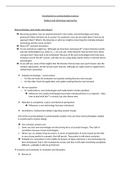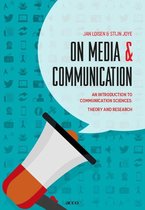Introduction to communication sciences
Medium and technology approaches
New technology, new media, new theory?
Recurring question; how to respond whenever new media, new technologies are being
produced? What will these do in society? As academics; how do we tackle them? How do we
approach them? What is the interplay or what are insights concerning the interplay between
technology and the social context?
About 20th centuries inventions
To one extend you might say; ‘Although we have been reviewing 20 th century theories mostly
and also technologies (e.g. radio, tv…). You can ask; ‘these theories that we have seen, these
concepts don’t they need to be revaluated? Because of the new technologies that have been
introduce end of the 20th century, and that we are using today mainly online or internet driven
technologies.
As we will see, some of the insights that the theories that we have seen put forward, also the
medium approaches, do still remain quite relevant. Although we might need to reapply them,
rethink them somewhat.
Interplay technology – social context
o On the one hand: Re-evaluation and update existing theories and concepts
o On the other hand: Re-application and update existing theories and concepts
No new question
o Cf. media history, new technologies and media lead to similar questions
Whenever new media technologies have been introduced there is a responds; ‘okey,
how to deal with this?’ in society, but also theory wise.
Attention to complexity, nuance and historical perspective
Whenever a new technology has been introduced
Nonetheless: fundamental debate regarding societal change
One of the recurring debate in communication studies; How are those new technologies related
to society and to society change
Two common answers are;
1. Some say; that new technologies are the driving force of societal changes. They talk of
revolution, because of new technologies
2. Others say; no, deeper lying structures, in terms of exploitation of some classes by the elite
or very strong media for example, that still persist. They prefer to talk about evolution.
Probably it is somewhere in the middle. Be beware of hypes whenever a new technology has
been introduced, that it will revolutionise society and that it will make everything completely
different , probably it will not go that fast.
evolution and continuity or revolution and disruption
Beware of
, o Hype
Be beware of hypes whenever a new technology has been introduced, that it will
revolutionise society and that it will make everything completely different , probably
it will not go that fast.
o boom or doom perspectives
often evaluated in terms of boom views; tv, window on the world, come into contact
with new cultures, ne people. Same story as was the case with internet for example.
Doom perspectives; ‘oh no, this new technology is going to be used to manipulated
people even more, even more hidden, powerful…
o utopia / dystopia
when new technologies has been introduced, they have been perceived in terms of
utopias or dystopias rep. boom or doom.
o Historical amnesia; and
The previous reveals a certain historical amnesia. Several of the questions that we
see, turning whenever new media has been introduced come back and we can learn
from this.
o Determinism
In any case, determinism, technological determinism, the idea that technology is
something autonomous and is also the driving force of societal change, is probably
not the best answer.
Research on new media and communication technologies
Dennis Miquail, one of the great summarizer of communication studies, asked the question;
Whenever new communication technologies have been introduced like is the case now or 20 years
ago of internet, technologies, aren’t we entering a scientific twilight zone than?
What does a new medium do?
We are studying things that are happening now
Basic reflections that every social scientist should have in this or her mind
Technology was there but the social use of technology was not yet there
Technological developments and social use came later, it didn’t develop
parallel
Non technological developments were also crucial to the further
investigation in new technologies
• New communication technologies: scientific twilight zone?
1. Complexity and multiplicity of the topic under investigation
A new medium, internet,… what does this do politically, in the political sphere?
Can we explain the raise of trump on the bases of his use of social media?
Probably many other aspects are being related; social dynamics in the U.S. and
, elsewhere in the world, social dynamics… A very complex topic that we
investigate and because of this new technology increasingly complexifying it
2. Uncertainty regarding future (technological) developments
We are studying things that are happening right now, and it is always very
difficult what will happen in the future. There is a fundamental uncertainty
whenever we are discussing new technologies and its impact or relation vice a
vice other societal spheres
Axioms social sciences research into (new) media
4 ideas for axioms, for basic reflections that any social scientist, researching new media
should have in the back of his or her mind.
1. Technological and societal evolutions not necessarily in parallel
This is seldom the case. We have seen this also in our overview of media history.
First picture, firs quarter almost of the 19 th century, but widespread use in society,
only a century later. The technology was there but the social developments, the
social use of that new technology would take on quite a while for it took of really in
society. The same for many other media except for the movies. They can go in
different direction.
2. What is technologically possible, does not necessarily happen
We assume this will be the case, and many things are possible
technologically. We focus on new technology successes, success stories, but
there are probably also as many failures of technologies that ones have been
introduced an might be good, might be interesting, but for some reason
didn’t really became widespread in society.
Because of other factors that are in the mix. What are those aspects then?
3. Importance of non-technological aspects in take up of media and communication
E.g. digital television; we all use it now, but that was already technically
feasible in the 1980’s. But many non-technological aspects were not insink
with the technological dynamic. For instance a digital tv set, the hardar itself,
it weight was a ton. You couldn’t really go to the media market, or ask
bol.com or something because you would need specialised transport, what
was also very expensive… people didn’t want to spend that much money on
a digital tv-set. The look and feel was not very user friendly. There was
handwear, but no software, no programs with that digital tv quality that we
now have. That was not so common in the 1980’s. All these elements made it
take much longer for digital tv to enter our society and to the widely spread
and use by us.
4. Limited predictability
Forward looking analysis Futurism
It is possible but it remains an open question of how thing will revolve in
sense of futural accounts, where the future is predicted





